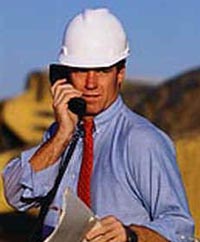OSHA
Requirements
 OSHA requires employers to ensure the safety of all employees in the work environment. Eye and face
protection must be provided whenever necessary to protect against chemical, environmental,
and radiological hazards or mechanical irritants.
OSHA requires employers to ensure the safety of all employees in the work environment. Eye and face
protection must be provided whenever necessary to protect against chemical, environmental,
and radiological hazards or mechanical irritants.
Ensuring worker safety includes conducting a workplace hazard assessment and providing adequate training for all workers who
require eye and face protection. When employees are trained to work safely, through the following requirements, they should
be able to anticipate and avoid injury from job related hazards.
|
| OSHA
Standards |
| The
following OSHA standards provide mandatory requirements
and compliance assistance for employers when selecting
proper eye and face protection:
The employer shall ensure that
each affected employee uses appropriate eye or face
protection when exposed to eye or face hazards from
flying particles, molten metal, liquid chemicals, acids
or caustic liquids, chemical gases or vapors, or
potentially injurious light radiation. To select PPE for
the workplace, see the Hazard
Assessment module.
|
 |
| Training
and Qualification of Employees |
Employers
must provide training for each employee who is required
to use PPE in the workplace. [1910.132(f)]
 Each
employee shall be trained to know at least the
following: Each
employee shall be trained to know at least the
following:
- When PPE is necessary
- What PPE is necessary
- How to properly don, doff, adjust, and wear
PPE
- Limitations of the PPE
- Proper care, maintenance, useful life, and
disposal of the PPE
- All training should be conducted by a
knowledgeable designated person.
- All required training should be presented in a
manner that the employee can understand.
- Each affected employee shall demonstrate an
understanding of the training specified and the
ability to use PPE properly, before being allowed to
perform work requiring the use of PPE.
- Employers who allow their employees to wear eye
and face protection on a voluntary basis when not
required by OSHA or the employer must implement
limited provisions of a PPE program. For all other
voluntary users, an additional written eye and face
protection program that covers proper maintenance
procedures must be implemented.
Retraining
- When the employer has reason to believe that any
affected employee who has already been trained does
not have the understanding and skill required, the
employer shall retrain that employee. Circumstances
where retraining is required include, but are not
limited to, situations where:
- Changes in the workplace render previous
training obsolete
- Changes in the types of PPE to be used render
previous training obsolete
- Inadequacies in an affected employee's
knowledge or use of assigned PPE indicate that
the employee has not retained the requisite
understanding or skill
Written Certification
- The employer shall verify that each affected
employee has received and understood the required
training through a written certification that
contains the name of each employee trained, the
date(s) of training, and the subject of the
certification.
Handling
Emergencies
 If
an eye injury occurs, quick action can prevent a
permanent disability. For this reason: If
an eye injury occurs, quick action can prevent a
permanent disability. For this reason:
- Emergency eyewashes should be placed in all
hazardous areas
- First-aid instructions should be posted close
to potential danger spots
- Employees must know where the closest eyewash
station is and how to get there with restricted
vision
|
 |
| Criteria
for PPE |
Eye
and face protection must comply with the American
National Standards Institute, ANSI Z87.1-1989 standard
if purchased after July 5, 1994 or ANSI Z87.1-1968 if
purchased before July 5, 1994. [1910.133(b)(1),
1915.153(b),
1926.102(a)(2)]
- Eye and face PPE shall be distinctly marked to
facilitate identification of the manufacturer. [1910.133(a)(4)]
- The following minimum requirements must be met by
all protective devices. Protectors shall:
- Provide adequate protection against the
particular hazards for which they are designed
- Be of safe design and construction for the
work to be performed
- Be reasonably comfortable when worn under the
designated conditions
- Fit snugly and not unduly interfere with the
movements of the wearer
- Be durable
- Be capable of being disinfected
- Be easily cleanable
- Be distinctly marked to facilitate identification only of the manufacturer
|
 |
| Fitting
of PPE |
Consideration
should be given to comfort and fit. Poorly fitting eye
and face protection will not offer the necessary
protection. [1926.102(a)(6)(iii)]
 Fitting
of goggles and safety spectacles should be done by
someone skilled in the procedure. Fitting
of goggles and safety spectacles should be done by
someone skilled in the procedure.
- Prescription safety spectacles should be
fitted only by qualified optical personnel.
- Devices with adjustable features should be fitted
on an individual basis to provide a comfortable fit
that maintains the device in the proper
position.
 Eye
protection from dust and chemical splash should form
a protective seal when fitted properly. Eye
protection from dust and chemical splash should form
a protective seal when fitted properly.
- Welding helmets and face shields must be properly
fitted to ensure that they will not fall off during
work operations.
|
 |
| Maintenance
and Care of PPE |
Employees
must be trained in the proper care, maintenance, useful
life, and disposal of PPE. [1910.132(f)(1)(v)]
Maintenance:
 PPE
must be used and maintained in a sanitary and
reliable condition. PPE
must be used and maintained in a sanitary and
reliable condition.
- The use of equipment with structural or optical
defects is prohibited. [1926.102(a)(4)]
- Pitted lenses, like dirty lenses, can be a source
of reduced vision. They should be replaced. Deeply
scratched or excessively potted lenses are apt to
break.
- Slack, worn-out, sweat-soaked, or twisted
headbands do not hold the eye protector in proper
position. Visual inspection can determine when the
headband elasticity is reduced to a point below
proper function.
Cleaning:
- Atmospheric conditions and the restricted
ventilation of the protector can cause lenses to
fog. Frequent cleansing may be necessary.
- Eye and face protection equipment that has been
previously used should be disinfected before being
issued to another employee.
- When employees are assigned protective equipment
for extended periods, the equipment should be
cleaned and disinfected regularly.
- Several methods for disinfecting eye-protective
equipment are acceptable. The most effective method
is to disassemble the goggles or spectacles and
thoroughly clean all parts with soap and warm
water.
- Carefully rinse all traces of soap and replace
defective parts with new ones.
- Swab thoroughly or completely and immerse all
parts for 10 minutes in a solution of germicidal
deodorant fungicide.
- Remove parts from solution and suspend in a
clean place for air drying at room temperature
or with heated air.
- Do not rinse after removing parts from the
solution because this will remove the germicidal
residue that retains its effectiveness after
drying.
Storage:
- Goggles should be kept in a case when not in use.
Spectacles, in particular, should be given the same
care as one's own glasses, since the frame, nose
pads, and temples can be damaged by rough usage.
- Items should be placed in a clean, dust-proof
container, such as a box, bag, or plastic envelope,
to protect them until reissue.
|
 |
| Contacts
and Prescription (RX) Lenses |
Employers
must ensure that employees who wear prescription (Rx)
lenses or contacts use PPE that incorporates the
prescription or use eye protection that can be worn over
prescription lenses. [1910.133(a)(3),
1915.153(a)(3),
1926.102(a)(3)]
 Workers
who wear prescription glasses must also wear
required eye protection. Workers
who wear prescription glasses must also wear
required eye protection.
- Eye and face protection that fits comfortably
over glasses is available.
- Safety goggles and spectacles may incorporate
prescription lenses.
- Dust and chemicals present additional hazards to

contacts wearers. OSHA recommends that workers
have an extra pair of contacts or eyeglasses in case
of contact failure or loss.
The employer shall ensure that
each affected employee uses appropriate eye or face
protection when exposed to eye or face hazards from
flying particles, molten metal, liquid chemicals, acids
or caustic liquids, chemical gases or vapors, or
potentially injurious light radiation. To select PPE for
the workplace, see the Hazard
Assessment module.
|
 |
|
|
